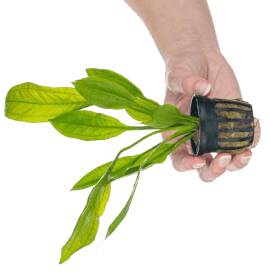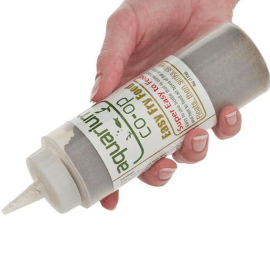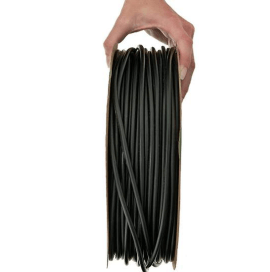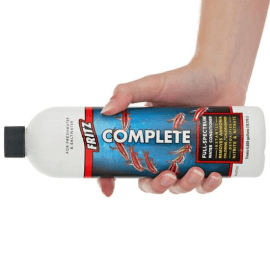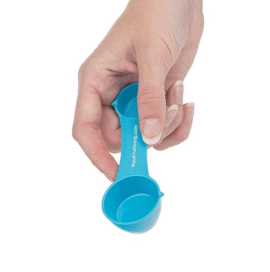Fish Tank Filters: Which One Should You Get?
What do most people think when they hear you keep pet fish? They probably conjure up memories of their great aunt’s dirty goldfish tank, covered in mystery slime and reeking of stagnant swamp water. But you and I know the secret to having a beautiful aquarium with crystal clear water… clearly, we just need to find the perfect fish tank filter!
Why do Aquariums Need Filtration?
As one of the key components of an aquarium, filtration is responsible for moving and cleaning the tank water, making it safe for fish to live in. The three main types of filtration are mechanical, biological, and chemical filtration. Certain filters are better at one type versus another, so here’s a brief overview of each category:
- Mechanical filtration uses sponges, filter socks, and filter floss pads that physically strain out debris from the water, much like a coffee filter. Mechanical filtration acts as a garbage can that collects trash – which means you as the fish owner are still responsible for cleaning the filter media (in other words, “emptying” the trash can before it overflows).
- Biological filtration uses beneficial bacteria or aquarium plants that can consume the toxic ammonia and nitrogen compounds that result from your fish’s waste. Beneficial bacteria grows on any surface, including the walls and gravel in your aquarium, so many filters come with biomedia or bio-rings with high surface area to provide more places for the bacteria to live.
- Chemical filtration uses activated carbon or special resins that can remove medications, tannins, and other impurities from the water. Once the chemical filtration becomes saturated with impurities, the media is no longer able to absorb pollutants from the water
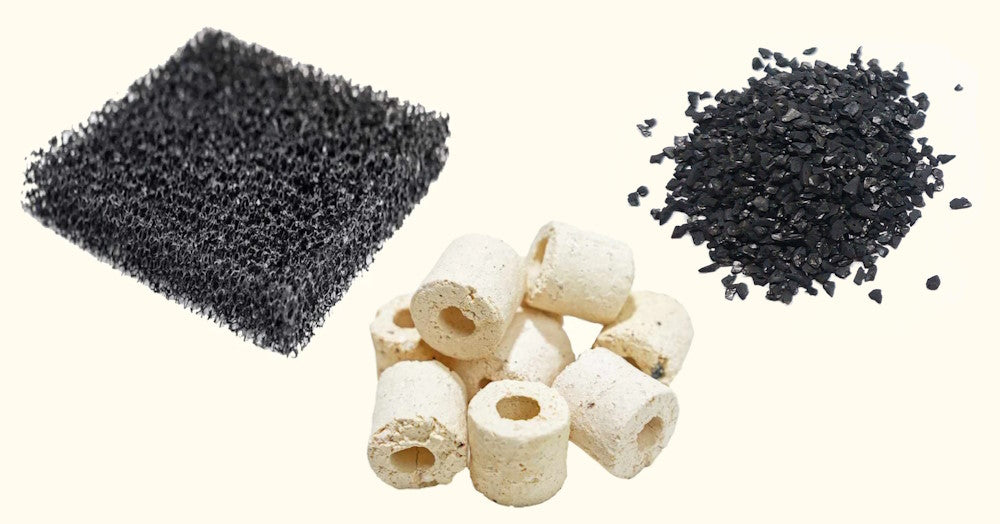
Examples of mechanical, biological, and chemical filter media
Bottom Line: mechanical filtration makes your water clearer, biological filtration makes your water safer, and chemical filtration is something best saved for removing impurities from the water.
What Are the Most Popular Types of Filters?
Now that you’re familiar with what filtration does for an aquarium, let’s talk about the actual equipment you can purchase (in rough order of most to least common).
Sponge Filter

Aquarium Co-Op sponge filters
This most basic of all filters requires at least three components: a sponge filter (which sits inside the tank), air pump (which sits outside the tank), and airline tubing to connect them. The air pump pushes air through the tubing into the hollow cavity inside the sponge filter. The rising bubbles of air draw water through the sponge walls, thus mechanically collecting debris from the water and giving beneficial bacteria place to grow.
Pros: I could go on and on, but this device is cheap, easy to clean, and hard to break since it has very few mechanical parts. It provides good water circulation and surface agitation, while being gentle enough to avoid sucking up fish fry, shrimp, and other slow-moving creatures. Plus, during power outages, the beneficial bacteria on the sponge stays in the oxygenated tank water (which gives it a longer chance of surviving), and you can even purchase battery-operated air pumps to prepare for emergencies.
The Aquarium Co-Op sponge filter comes with a few extra features as well. The Easy Flow curved uplift tube helps to improve water circulation to minimize stagnant zones that are prone to growing algae and ensure that plant nutrients and heat are evenly distributed throughout the aquarium. It also has a special air collar which creates smaller bubbles much like an air stone. These little bubbles help to create more continuous flow and optimize the sponge filter's performance.
Cons: The sponge filter takes up physical space in the fish tank, so you may want to hide it behind a rock, plants, or other aquarium decor. Also, it can be difficult to add chemical filtration, but some hobbyists have successfully used our chemical filtration pads by wrapping them around the sponge with a rubber band.
Bottom Line: Sponge filters are frequently found in fish stores, fish rooms, and breeding facilities because they’re so reliable and cost-effective. Why not use what’s tried and true?
Hang-on-Back Filter
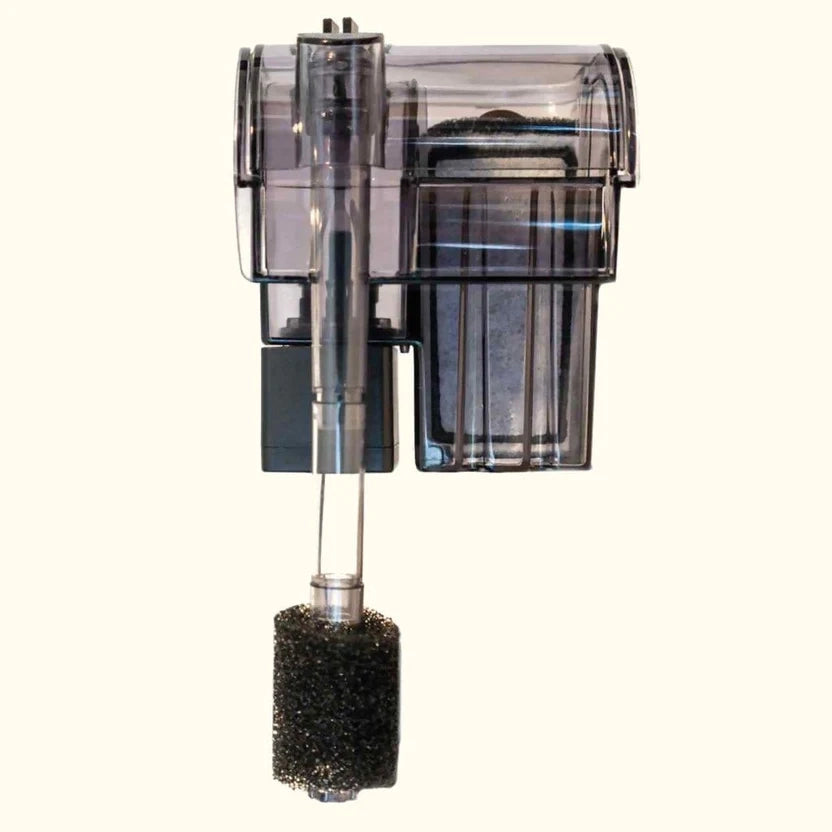
Hang-on-back filter for nano tanks
Just as the name describes, a hang-on-back filter sits on the top rim of an aquarium with the filter box hanging outside the tank and the intake tube lowered into the tank. Water is sucked up the intake tube via the filter’s motor, passed through all the media in the filter box, and then typically returned back into the aquarium like a mini waterfall.
Pros: I love how customizable the filter media is and the fact you can include all three types of filtration. In fact, I’d say a hang-on-back filter is even better at mechanical filtration than a sponge filter because you can add a fine filter pad to really polish the water. The device is very simple to service since most of the media is outside of the aquarium, allowing you to easily remove the media for gentle washing. Plus, the AquaClear filter I own has an adjustable flow rate, so I can really crank up or slow down the water circulation as needed.
Cons: Because a power motor drives the water flow, there’s a chance it can burn out if the filter runs dry or accidentally sucks up sand (use a pre filter sponge to prevent the latter). Additionally, if you don’t like the waterfall sound, just raise the water level in your aquarium and you’ll barely notice the noise.
Bottom Line: This is the first filter I ever purchased and it’s still in use today for good reason. As a popular staple in the freshwater aquarium hobby, the hang-on-back filter excels in all three arenas of filtration and has extremely flexible options for hot-rodding it to your tastes.
Canister Filter
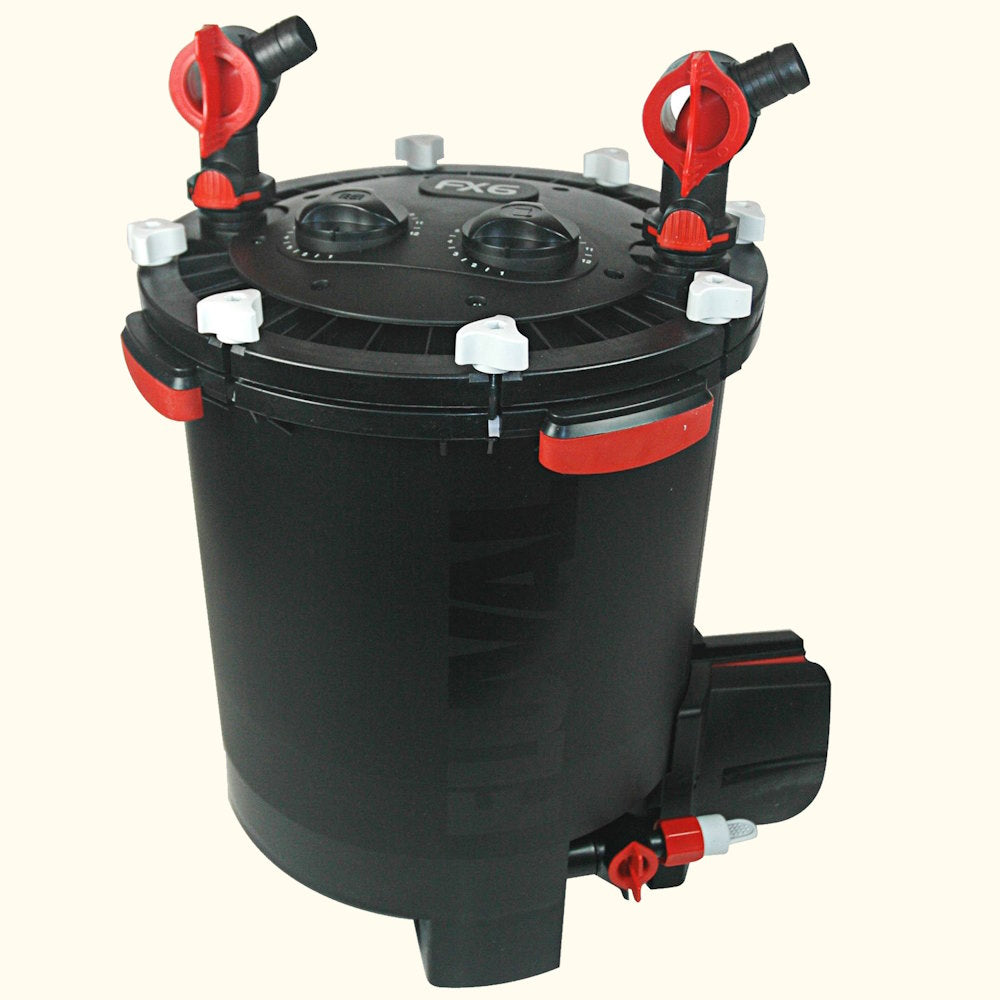
Canister filter
A canister filter is essentially filtration in a plastic cylinder or box form factor that often sits under the tank, with intake and output hoses that reach into the aquarium. With the aid of a motor, water is drawn into the canister, travels through several trays of filter media, and then is returned to the fish tank.
Pros: Just like the hang-on-back filter, the canister filter takes up very little room inside the aquarium and is highly customizable. In fact, some models come with fancy bells and whistles like an inline heater, UV sterilizer, and automatic priming. As one of the most powerful and quiet options on the market, many hobbyists consider this to be the king of all readymade filters.
Cons: You have to pay for performance, and the price tag on this one can be a little steep. Also, that nifty little canister is pretty difficult to service, requiring you to practically disassemble the whole setup every time you want to clean out the insides. (Note: there’s a greater chance for flooding during maintenance, so keep those towels handy!) Finally, because the filter media lives outside the aquarium in a closed box, there’s a greater risk of suffocating and killing off your beneficial bacteria during a power outage.
Bottom Line: If you need extremely clean water for your discus or have an overstocked African cichlid tank with heavy bioloads, this may be the best option on the market for you. Just be prepared to spend the extra money and time it takes to own this premium product.
Fluidized Bed Filter
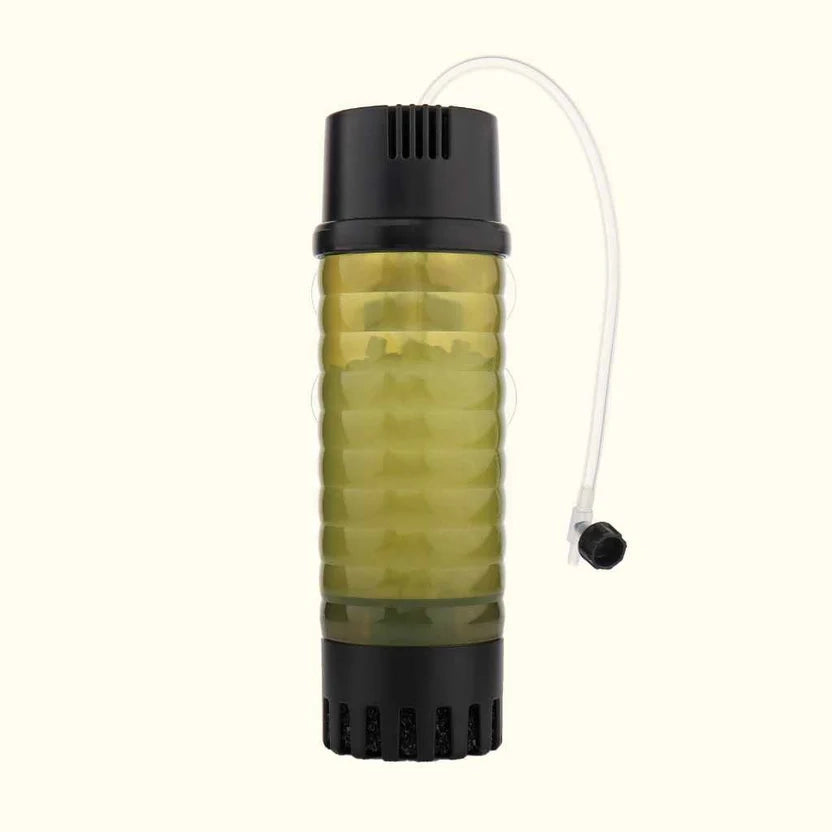
Ziss moving bed filter, powered by an air pump
Traditionally, fluidized bed filters have been more of a DIY approach to filtration, but now there’s a compact, off-the-shelf version known as the Ziss Bubble Moving Media Filter. Water flows into a chamber of small media granules (like sand or plastic pellets), causing the media to swirl about like a fluid. This constant churning greatly enhances bacteria growth from the media’s constant contact with oxygenated water.
Pros: The Ziss filter is air-driven like the sponge filter, so it has very few mechanical parts to break and provides plenty of surface agitation for increased gas exchange. It comes with a sponge prefilter at the bottom that prevents fry from getting sucked up and is easy to remove for maintenance. As a device focused on biological filtration, it’s great for goldfish and turtle aquariums with high bioloads – and unlike sponge filters, the hard plastic is too hard for turtles to chomp through!
Cons: This filter is relatively tall at 11 inches, so it’s only suitable for taller tanks (not a 10 gallon or 20 gallon long aquarium). Like the sponge filter, it’s not as customizable for adding chemical filtration or more mechanical filtration. And I’d say the noise level is also comparable to a sponge filter (mostly coming from the bubbles and air pump itself).
Bottom Line: If you’re looking to boost your biological filtration, consider a fluidized bed filter. One Ziss Bubble Bio filter handles about 20 to 40 gallons of water and can be used either by itself or in conjunction with another filter.
Live Aquarium Plants

Planted aquarium full of healthy, growing plants
I bet you thought this entire blog post was going to be about equipment, right? Surprise! Live aquarium plants provide excellent biological filtration that’s even more effective than beneficial bacteria, according to microbiologist Diana Walstad. If you think about how plants work, they absorb ammonia and nitrogen compounds from the soil to grow – and these are the very same compounds produced by fish and organic waste in your aquarium.
Pros: If you’re familiar with the aquarium nitrogen cycle, beneficial bacteria consume ammonia to make nitrates, which is still toxic in large amounts and must be manually removed from an aquarium via water changes. However, plants use both ammonia and nitrates to make more leaves, which in turn allows you to go longer between water changes. In addition, live plants provide shelter for shy or small fish, produce oxygen for your fish (during the daytime), and help reduce algae by using up nutrients in the water. Finally, have you ever seen a jaw-dropping aquascape with lush foliage and driftwood? Recreating a small slice of nature in my home is definitely one of the main reasons I got into the hobby.
Cons: Just as there’s a lot to learn about keeping fish, expect a learning curve when growing plants as well. Plants won’t provide any mechanical or chemical filtration, so you can add equipment for extra filtration or water circulation. Also, you’ll need to remove algae, prune dead leaves, and possibly fertilize as part of your regular tank maintenance.
Bottom Line: Start with easy beginner plants like java fern and anubias that don’t require any special lighting or substrate. Your aquarium will look amazing and your fish will thank you for it!
Which Filter Should I Get?
Ah, the golden question every aquarist always wants to know. First off, there are plenty of other filters that I didn’t cover (e.g., internal filters, sumps, and undergravel filters). Secondly, there’s no such thing as a one-size-fits-all “best” filter, but rather a wide variety of different tools that can best accomplish different tasks. Consider the needs of your aquarium – such as your stocking levels, water circulation, ease of use, and budget – and pick the solution that works for you. Good luck and happy filter shopping!
